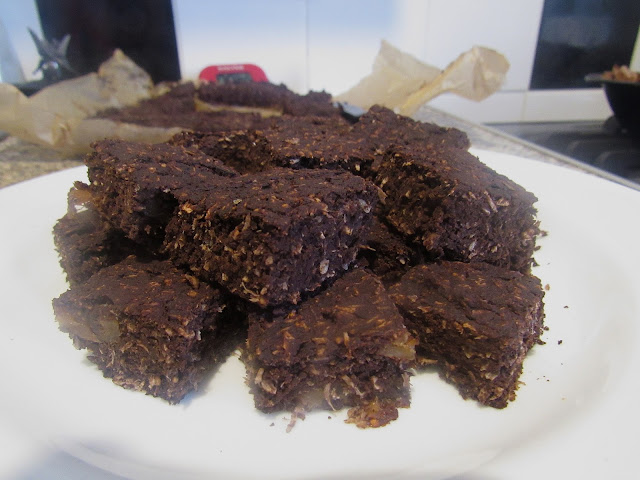So this week I finally handed in my PhD thesis (and started a new job to boot!). To thank my lab for all their hard work looking over the thesis, I decided to bake an elaborate cake. The base cake is a deep chocolate-y brownie - so delicious I may use it for my standard chocolate cake in the future! I also decided to try out a new kind of buttercream that I've seen on quite a few American baking/cake decorating shows, but not many in the UK. Swiss meringue buttercream is silky and smooth, and not as rich as classic buttercream (which still holds a dear place in my heart). Using brown sugar and cinnamon gave the buttercream a delicious deep flavour of a cinnamon roll (divine!)
I gave the cake a slight ombre effect (where the buttercream goes from dark to light), but I admit, it's pretty subtle.
The macarons are optional - I think they add a nice touch - I slightly modified a previous recipe, and this makes a lot of macarons (at least 30 halves). If you don't fill them, they freeze really well to be used on another occasion OR just fill them as an extra delicious treat :) I filled them with the spare Swiss meringue buttercream for macaron bliss :) My other macaron recipes (cinnamon spiced and chocolate raspberry) have some other filling recipes.
One important point for the Swiss meringue buttercream - your butter MUST be at room temperature. The best way to achieve this is to leave it out of the fridge for 24 hours prior to use. It's very tricky to get the butter to the correct temperature in the microwave so this will save you a big headache.
Makes one 20cm cake
Ingredients:
For the cake:
- 250g (1 cup) unsalted butter
- 200g (1 & 1/3 cups) dark chocolate (55% cocoa solids)
- 300g (1 & 1/2 cups) granulated sugar (or brown sugar for an extra caramel note)
- 4 tbsp water
- 100g (2/3 cup) dark chocolate chips
- 4 medium eggs
- 200g (1 & 2/3 cups) plain flour
- 75g (1/2 cup) chopped walnuts
- 30g (4 tbsp) cocoa powder
For the cinnamon brown sugar Swiss meringue buttercream:
- 6 egg whites
- 300g (1 & 2/3 cups) brown sugar
- 400g (1 & 3/4 cups) unsalted butter, cut into 1-2cm cubes (ROOM TEMPERATURE)
- 1-2 tbsp ground cinnamon (to taste)
- 2 tsp cocoa powder (optional)
For the chocolate drip:
- 150g (1 cup) dark chocolate (70% cocoa solids)
- 100g (7 tbsp) unsalted butter
For the macarons:
- 170g (1 & 2/3 cups) icing sugar
- 160g (1 & 1/3 cups) ground almonds
- 4 medium egg whites
- 1 tbsp lemon juice
- 160g (3/4 cups & 1 tbsp) granulated sugar
- 50ml water
- ivory food colouring (optional)
To finish:
- 30g (2 tbsp) chopped walnuts
- 50g (1/3 cup) milk chocolate
Method:
To make the cake layers:
1. Preheat your oven to 180c (160c fan)/ 355F/ gas mark 4 . Grease two 20cm springform or loose bottomed round cake tins, then tip in about 1 tbsp of cocoa powder. Tap the tin to evenly distribute the cocoa.
2. In a saucepan melt together the 200g dark chocolate (broken into chunks), unsalted butter (chopped into chunks), sugar and water. Once all of the butter and chocolate have melted set aside to cool for a few minutes.
3. In a large mixing bowl pour in the chocolate/butter melted mixture. Add the chocolate chips, eggs, flour, chopped nuts and cocoa powder, and beat until smooth.
4. Pour into the prepared cake tins (get them as even as possible), and bake for 18-20 minutes, until the top of the cake feels springy and the top feels crisp. If you shake the tin, there should be a small amount of wobble in the very centre of the cake - this will make the layers moist and delicious.
5. Leave the cakes in their tins to cool for 10 minutes, then remove onto a wire rack to cool completely.
6. Level the top of the cakes using a serrated knife (eat the cut offs if you want a chef's perk!)
To make the buttercream:
1. Place a few tablespoons of water in a small saucepan, and get a heatable mixing bowl (i.e. not a plastic one!) that can fit on the saucepan without touching the water. Into this bowl add the egg whites and brown sugar.
2. Place the saucepan on a low heat, and place the mixing bowl on top. Use an electric whisk to beat the egg whites/brown sugar, until the mixture reaches 71c/ 160F. This will take about 10 minutes.
3. Remove the bowl from the heat, and tip the egg white/sugar mixture into another large mixing bowl (this will help the meringue to cool a bit faster).
4. Use an electric whisk to beat the meringue until it is glossy and a stiff peak of meringue forms when the whisk is lifted from the mixture (i.e. a peak falls where the tip stays upright and doesn't fall to either side).
5. Whilst whisking, add the butter chunk by chunk. Don't be tempted to add more than a chunk at a time, as the mixture may curdle. Keep beating, until all of the butter has been added and the buttercream is smooth.
6. Add the cinnamon and whisk in briefly. If you want to try out the ombre effect, take out 3 tbsp of the buttercream into another bowl, and whisk the 2 tsp of cocoa into that buttercream. Set aside until ready to use.
To start assembly:
1. Place a small amount of buttercream on the serving dish/cake board and stick the first cake layer onto the board.
2. Using a palette knife, spread buttercream onto the cake so that it is about 1/2 cm high and reaches the edges of the cake.
3. Top with the other cake layer. Smooth over a layer of buttercream on the top and around the edges of the cake - this is known as the crumb coat, and is a thin layer of buttercream that will make your cake seem more professional when done.
4. Place the cake in the fridge to set for 20 minutes.
5. Place a few large spoonfuls of buttercream on the top of the cake, and use a palette knife to smooth the buttercream over the top as evenly as possible.
6. If attempting the ombre cake, place the cocoa buttercream in a piping bag, and cut off 1cm from the tip. Pipe around the base of the cake two times to form to rings.
7. Place the remainder of the cinnamon buttercream into another piping bag and cut as previously. Pipe rings around the rest of the sides of the cake. Use any remainder buttercream to fill macarons!
If you don't want the ombre effect, simply dollop on a large amount of buttercream on the side of the cake so that vertically it covers the whole section. Then use a palette knife to spread the buttercream around as much of the side as possible. Repeat until the whole of the cake is covered, then run the knife around the cake one more time to remove any "seams" the knife may have made.
8. Place a long palette knife (or a dough scraper) vertically against the side of your cake, and slide it around the sides of the cake. Place any excess buttercream into a bowl. Don't worry if you have some bald patches, just take your time and add more buttercream to those areas. Then smooth over again.
9. Place in the fridge for 20 minutes to set.
For the chocolate drip:
1. Melt the chocolate and butter in a saucepan. Once all of the butter and chocolate have melted, pour into a measuring jug and leave to cool until it is 30c/ 86F. This will take at least 10-15 minutes.
2. Pour onto the middle of the top of the cake, and use a palette knife to smooth the chocolate to the edges. Gently use the knife to smooth over the edge and create the drip effect. Ideally you want the drips to be different lengths so smooth over more or less of the chocolate drip when you want a longer or shorter drip, respectively.
3. Place in the fridge to set.
For the macarons:
1. Blitz the icing sugar and the ground almonds in a food processor, pulsing it around 10 times until well mixed. Sieve into a mixing bowl.
2. Add 2 egg whites to the icing sugar/ground almonds and beat to a paste.
3. Clean a mixing bowl well, and wipe the lemon juice over the inside of the bowl and the beaters for an electric whisk. Pour the remaining 2 egg whites into the bowl, and whisk until it is foamy and stiff peaks form.
3. Meanwhile, in a medium saucepan heat the granulated sugar and water until the sugar syrup reaches 118c/ 244F.
4. Whilst whisking (being careful to not touch the sugar syrup), pour the sugar syrup slowly onto the egg whites. Keep whisking on a high speed until the meringue is glossy and forms stiff peaks. You have essentially now made Italian meringue.
5. Spoon one third of the meringue mixture onto the macarons, and beat in - at this stage you don't need to worry about over beating.
6. Add the remaining meringue mixture, and gently fold in. Once no more egg white can be seen, divide the mixture into two separate bowls. Colour one ivory and leave one plain.
7. Grease and line the base of 3 baking trays with baking parchment. Pour the macaron mixture into a piping bag, and cut off the tip 1cm from the end. On two baking sheets pipe 4cm circles of macarons, leaving at leave 1&1/2 cm between each macarons. On the third sheet pipe 1cm circles.
8. Tap the base of the baking trays against the kitchen surface and leave for at least half an hour for a "skin" to form - this means that when you touch the macaron lightly, no mixture sticks to your finger.
9. Preheat the oven to 170c (150c fan)/ 340F/ gas mark 3. Before placing in the oven tap the baking sheets once more against the kitchen surface. Bake the larger macarons for around 8 minutes, until the tops look crisp and firm. Bake the smaller macarons for around 4 minutes.
10. Leave to cool.
11. Fill with the remaining buttercream (or spare chocolate drip).
To assemble:
1. Melt the milk chocolate in a microwavable bowl on high power for 20 second bursts in the microwave, stirring well after each addition.
2. Once melted pour into a piping bag and cut off the 1/2 cm from the tip. Pipe drops (around 1cm in diameter) onto a sheet of baking paper. You could also pipe any other shape or design you wanted :)
3. Place some of the macarons on the top of the cake as you like. Scatter over the chopped walnuts and chocolate drops.
4. Enjoy!!
















